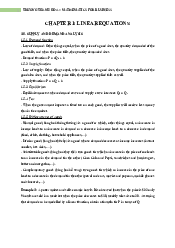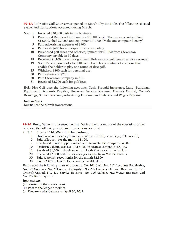

















Preview text:
1 MATH FOR BUSINESS TA: VŨ THỊ THU TRANG Chapter 1: Linear Equations
1. Supply and Demand analysis *Demand function: P= aQd + b *Supply function: P= aQs + b
*At equilibrium point: Qd = Qs Given P = aQd + b (1) P = cQs + d (2)
At equilibrium point, we have Pe = PD = P s Qe = d Q = Qs
*Tax: Find the equilibrium price and quantity if the government imposes a tax of $t on each good.
=> The new supply function is: Ps – t= cQS + d Ps = cQS + d + t
+ Tax is paid by customer và supplier:
• Customer pay = P (at new equi’ point) – P (at old equi’ point)
• Supplier pay = tax – customer pay
• Tax revenue = tax per unit x Q’ (number of goods sold with tax)
= tax x Q (at new equi’ point)
*Note: Khi đề cho 2 sản phẩm với demand và supply của mỗi sản phẩm thì PD1 = PS1 và PD2 = PS2
Example: The demand and supply functions of a good are given by P = −4Qd + 120
2 MATH FOR BUSINESS TA: VŨ THỊ THU TRANG 1 P = 𝑄 3 𝑠+29
where P, Qd and Qs denote the price, quantity demanded and quantity supplied respectively.
(a) Calculate the equilibrium price and quantity.
(b) Calculate the new equilibrium price and quantity after the imposition of a
fixed tax of $13 per good. Who pays the tax? ---
(a) In equilibrium, Qd = Qs = Q, so P = −4Q + 120 1 P = 𝑄+29 3 1 Hence, −4Q + 120 = 𝑄+29 3 => Q= 21 1 P= .21+ 29= 36 3
The equilibrium quantity is Q = 21 and the equilibrium price is P = 36.
(b) After the imposition of a $13 of tax per good, the supply function becomes P – 13 = 13𝑄𝑠+29 P = 13𝑄𝑠+42
The demand equation remains unchanged, so, in equilibrium, Qd = Qs = Q P = −4Q + 120 P = 13𝑄+42
Hence, −4Q + 120 = 13𝑄+42
The equilibrium quantity is Q = 18 and the equilibrium price is P = 48.
*Tax is paid by customer và supplier:
• Customer pay = 48 – 36= 12
• Supplier pay = 13 – 12= 1
Therefore, the consumer pays an additional $12. The remaining $1 of the tax is paid by the firm.
3 MATH FOR BUSINESS TA: VŨ THỊ THU TRANG
*Sketch the line:
Step 1: lập bảng giá trị (table of values), lấy ít nhất 2 giá trị cho mỗi phương
trình, trong đó nên lấy 1 giá trị tại equilibrium point (intersection) để dễ nhìn
hình và làm các câu kế tiếp.
Step 2: Vẽ hình (chú ý: lần lượt kí hiệu Q, P cho x-axis & y-axis, kí hiệu S và
D cho các đường thẳng tương ứng đã vẽ, lấy giao điểm E tại equilibrium point)
2. Different types of goods
- Normal good (hàng hoá thông thường) is a good for which, other things
equal, an increase in income leads to an increase in demand or a decrease in
income leads to a decrease in demand (food, drink, clothing, household appliances,…)
- Inferior good (hàng hoá thứ cấp) is a good whose demand decreases as
income increases (instant noodles, bus rides,…).
- Substitutable goods (hàng hoá thay thế): two goods for which an increase in
the price of one leads to an increase in the demand for the other (Coca Cola
and Pepsi, sandwiches and hamburgers, butter and margarine,…).
4 MATH FOR BUSINESS TA: VŨ THỊ THU TRANG
- Complementary goods (hàng hoá bổ sung): two goods for which an increase
in the price of one leads to a decrease in the demand for the other (petrol and
cars, movies and popcorn, mobile phones and simcards,…). Chapter 2: Non-Linear Equations
1. Sketch the graph Parabol: y= ax2+bx+c
- Step 1: Determine the basic shape.
if a > 0: the graph has a U shape
if a < 0: an inverted U shape - Step 2: y=0 => x1, x2
5 MATH FOR BUSINESS TA: VŨ THỊ THU TRANG - Step 3: nh I ( Đỉ
− 𝑏 ; − ∆ ); ∆= 𝑏2 − 4𝑎𝑐 2𝑎 4𝑎
- Step 4: Determine the intercept. This is obtained by substituting x = 0
into the function, which gives y = c.
2. Revenue, cost and profit
Total revenue: TR = PxQ (tổng doanh thu)
Total cost = Fixed costs + total variable costs (tổng chi phí)
TC = FC + TVC = FC + (VC)Q 𝑻𝑪 𝑭𝑪+𝑽𝑪(𝑸) 𝑭𝑪
=> Average cost: AC = = = + VC 𝑸 𝑸 𝑸
Profit = Total revenue – total cost π = TR − TC
o Make a profit of a units: π = a
o Make a loss of a units: π = -a o Breaks even: π = 0
o Maximise profit: πmax when 𝜋′=0 𝑎𝑛𝑑 𝜋′′<0.
Example: If fixed costs are 4, variable costs per unit are 1 and the demand function is P = 10 − 2Q
obtain an expression for π in terms of Q.
(a) For what values of Q does the firm break even?
(b) What is the maximum profit? --- TC = 4 + Q TR = PQ = 10Q – 2Q2
𝜋= 𝑇𝑅−𝑇𝐶 =10𝑄−2𝑄2−4−𝑄=−2𝑄2+9𝑄−4
(a) The firm breaks even when 𝜋=0=> −2𝑄2+9𝑄−4=0
6 MATH FOR BUSINESS TA: VŨ THỊ THU TRANG 1 Therefore, Q = 4 and 𝑄= 2
(b) Profit maximises when 𝜋′=0 𝑎𝑛𝑑 𝜋′ < ′ 0.
𝜋′= −4𝑄 + 9 𝑎𝑛𝑑 𝜋′′= −4 < 0 9 9 𝜋′= 0 => 𝑄
= 94 => 𝜋= −2 𝑥 ( )2 +9𝑥 −4= 49 =6.125 4 4 8
Therefore, the maximum profit is 6.125 3. Indices and logarithms
- Production function: Q = f(K,L)
- The production function is said to be homogenous if 𝑓(𝜆𝐾,𝜆𝐿)=𝜆𝑛𝑓(𝐾,𝐿)
• n < 1, the function is said to display decreasing returns to scale.
• n = 1, the function is said to display constant returns to scale.
• n > 1, the function is said to display increasing returns to scale.
- Cobb–Douglas production functions: Q = AKαLβ → homogeneous of degree α + β (n= α + β)
Example: Show that the following production functions are homogeneous
and comment on their returns to scale: (a) Q = 7KL2 (b) Q = 50K1/4L3/4 ---
(a) f(K,L) = 7KL2 𝑓(𝜆𝐾,𝜆𝐿)= 7(𝜆𝐾)(𝜆𝐿)2 2 3
=7𝜆𝐾𝜆 𝐿2=𝜆 7𝐾𝐿2=𝜆3𝑓(𝐾 𝐿 , )
7 MATH FOR BUSINESS TA: VŨ THỊ THU TRANG
=> Increasing returns to scale because n = 3 > 1 (b) f(K,L) = 50K1/4L3/4
𝑓(𝜆𝐾,𝜆𝐿)=50(𝜆𝐾)1/4(𝜆𝐿)3/4=𝜆 50𝐾 1/4𝐿 3/4=𝜆 ( 𝑓 𝜆𝐾,𝜆𝐿)
=> Constant returns to scale because n = 1 Chapter 3: Mathematics of Finance I. Percentage 1. Percentages |𝑥2−𝑥1| - Percentage: x 100% 𝑥1
• x2 – x1 > 0 → Increase
• x2 – x1 < 0 → Decrease
- Scale Factor (hệ số tỉ lệ)
𝑁𝑒𝑤 𝑣𝑎𝑙𝑢𝑒 SF = = 1 ± r% Old value - The new value: Đề bài bắt tính Increase Decrease Gia trị trước khi có r% Đề cho ÷ SF (SF= 1+r) Đề cho ÷ SF (SF= 1-r) Gia trị sau khi có r% Đề cho x SF (SF = 1+r) Đề cho x SF (SF = 1-r ) Example:
(a) The value of a good rises by 13% in a year. If it was worth $6.5 million at
the beginning of the year, find its value at the end of the year.
(b) The GNP of a country has increased by 63% over the past 5 years and is
now $124 billion. What was the GNP 5 years ago?
8 MATH FOR BUSINESS TA: VŨ THỊ THU TRANG
(c) Sales rise from 115 000 to 123 050 in a year. Find the annual percentage rise. --- 13
(a) The rise in value is 6.5 x = 0.845 100
The value at the end of the year is 6.5 + 0.845 = 7.345
(*) Or we can use scale factors: 𝑥 13 = 1+ =1+ 0.13= 1.13 x = 7345 6.5 100
Therefore, the value of an investment at the end of the year is 7345 124 (b) The GNP 5 years ago is: =76 1+ 63 100
(c) The annual percentage rise is 𝑥 115,000(1+ )=123050 =>𝑥=7% 100
- Overall Scale = SF1 x SF2 x ... x SFn
Example: Find the single percentage increase or decrease equivalent to
(a) an increase of 30% followed by an increase of 40%.
(b) a decrease of 30% followed by a decrease of 40%.
(c) an increase of 10% followed by a decrease of 50%. ---
(a) (1 + 0.3)(1 + 0.4) = 1.82, which corresponds to an 82% increase.
(b) (1 – 0.3)(1 – 0.4) = 0.42, which corresponds to a 58% decrease (nếu đáp
án nhỏ hơn 1 thì lấy 1 trừ
đi đáp án để tính được % giảm).
(c) (1 + 0.1)(1 – 0.5) = 0.55, which corresponds to a 45% decrease. 2. Application 2.1. Index numbers
Index number = scale factor from base year x 100
9 MATH FOR BUSINESS TA: VŨ THỊ THU TRANG
𝑟𝑒𝑎𝑙 𝑣𝑎𝑙𝑢𝑒 𝑖𝑛 𝑜𝑛 𝑠𝑒𝑟𝑣𝑎𝑡𝑖𝑜𝑛 𝑦𝑒𝑎𝑟 = x100
𝑣𝑎𝑙𝑢𝑒 𝑖𝑛 𝑏𝑎𝑠𝑒 𝑦𝑒𝑎𝑟 => SF = Index number : 100
Example: Table shows the values of household spending (in billions of
dollars) during a 5-year period. Calculate the index numbers when 2010 is
taken as the base year and give a brief interpretation.
- Index number in base year = 100
- The value in n year = [(Index n)/100] x The value in base year 𝐼𝑛𝑑𝑒𝑥 𝑥 𝑆𝐹 𝑥 𝑣𝑎𝑙𝑢𝑒 𝑥 - = = 𝐼𝑛𝑑𝑒𝑥 𝑦 SF y value y 2.2 Inflation SF = 1 + Inflation(%)
- Nominal data: raw data without adjusted base on inflation....
- Real data: has been adjusted with inflation
10 MATH FOR BUSINESS TA: VŨ THỊ THU TRANG
*Calculate real value/ adjusted value: Forward Base year Backward Nominal x Overall Scale N
ominal Nominal : Overall Scale *Note:
- Nếu đề cho bài toán ngược (yêu cầu tìm nominal value) thì làm ngược lại
- Năm bắt đầu lạm phát real value = Nominal
+ Sau lạm phát: real < nominal
+ Trước lạm phát: real > nominal
Example: Table shows the average annual salary (in thousands of dollars) of
employees in a small firm, together with the annual rate of inflation for that year.
Adjust these salaries to the prices prevailing at the end of 2001 and so give the
real values of the employees’ salaries at constant ‘2001 prices’.




